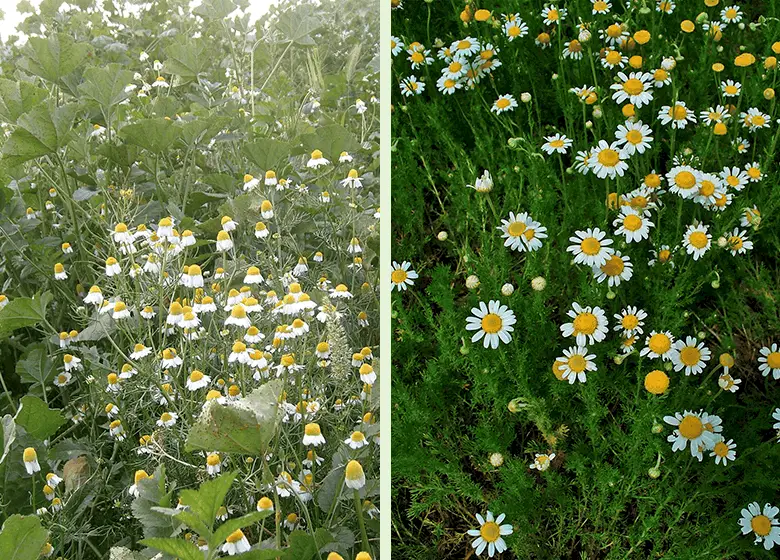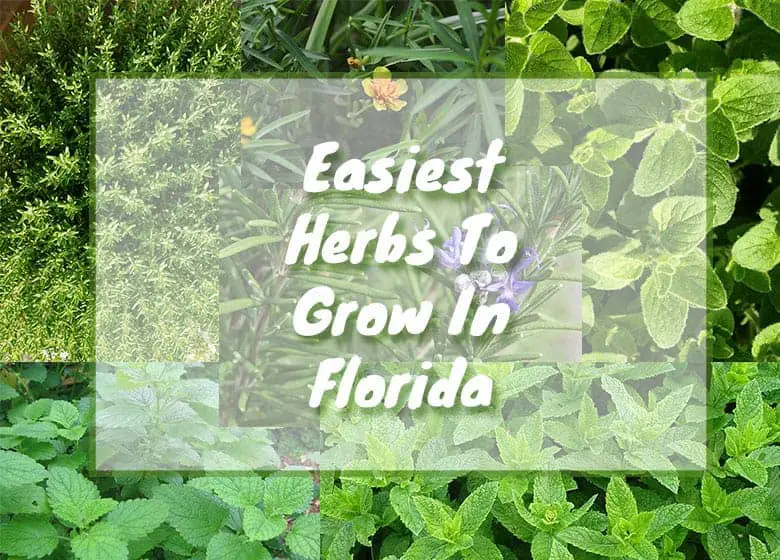Can you grow chamomile in Florida?
Yes, Chamomile will grow in Florida. The chamomile plant is an incredibly easy herb to cultivate. It grows wild in western Asia, India, and western Europe. It is also abundant in the US, and it can be spotted in sunny well-drained regions, pastures, and roadsides.
Chamomile can be grown in either the Roman and German varieties, which grow in similar conditions. Cultivating the herb from seed is fairly easy, and once it is established, it will require very little care.
Chamomile thrives the best when it is not disturbed. It is also quite drought-tolerant, and it should only be watered in the case of extended drought.
Varieties of Chamomile
Chamomile is commonly divided as either Roman and German. They are in the same family, have similar-looking flowers, and have the same chemicals. The plants, however, have noticeable differences as described below

Roman Chamomile
Roman chamomile is commonly called “English” or “true” chamomile. It is a perennial when cultivated in a warm climate. When it is grown in part shade, it reaches heights of 12 inches and spreads via root systems. It has characteristically hairy stems, and a single flower is produced on top of one stem. The flowers have yellow rounded disks and white petals and are around 15 to 30 mm in diameter. The foliage is feathery and fine.
Roman chamomile was named in the 19th century after a botanist spotted it thriving in the ruins of the Coliseum. It is indigenous to western and southern Europe, eastern Africa, and the Middle East. In England, the plant is popular as an earth-friendly lawn alternative. When used as a tea herb, Roman chamomile tends to be sweeter than the German variety.
German Chamomile
German chamomile is an annual herb. It can get bitter although it still has the apple favor associated with chamomile. Its stems are smooth and not hairy. The essential oil has a blue color, because of high concentrations of azulenes.
It is taller at 24 inches, although it does not spread out as much as Roman chamomile.Sometimes called Hungarian Chamomile since it is native to the country in addition to Egypt, Eastern Europe, and France. It is cultivated commercially in the US, Belgium, Argentina, France, and England.
All the plant’s parts can be used in salads, although they may have a bitter quality.
Both varieties have traditionally been used to treat anxiety and sleep-related conditions. They can also come in handy in addressing digestive ailments and colds.
German chamomile is sometimes regarded as the better variety for external applications. Some people deem its bitter quality unfavorable for making beverages. All parts of German chamomile can be used.
Roman chamomile contains more of the apple flavor and the sweetness characteristic of chamomile tea. It, therefore, provides a universal appeal when it comes to beverages. The variety can also be used as a salad green.
Planting Chamomile in Florida
You can begin chamomile seeds indoors about six weeks before the last frost of winter. In South Florida this mean pretty much anytime of the year. In north and central Florida you can plant in February or March.
Start the seeds in pots, but do not bury your seeds under the soil.
The seeds sprout with sufficient light so you can just sprinkle several seeds in every pot right on the surface of the potting soil. Keep the soil moist, and reduce them to one seed for every pot after they begin to sprout.
If you are using containers to grow the plants, you can sprout the seeds directly into the growing container if maintained indoors until the frosts are past.
When it comes to transplanting, you want your seedlings about 12 to 18 inches away from each other. Sunny locations are ideal for the herb, but they will thrive with some amount of shade as well.
Transfer them to the garden after fear of all frost is gone. Chamomile commonly seeds itself, so you can leave some blossoms to seed to create a permanent chamomile bed.
Chamomile seeds can also be planted directly into the garden instead of transplanting. The seeds can be sown in early spring. They can also be put out in our fall conditions.
It grows incredibly well in containers, although it will grow larger than standard window-sill pots. Every plant should be fitted in a 12-inch pot.
The herb is a good companion plant for cucumbers, onion, basil, wheat, and cabbage.
It will also boost the essential oil production of other herbs planted in proximity to it.
If you have poor soil, opt for the German variety as it is much more hardy.
Caring for Chamomile
Roman chamomile loves well-drained, fertile soil. A sufficient layer of organic mulch will prevent weed growth while helping the soil to retain moisture.
Aged bark or shredded leaves are a good mulch option. When placing the mulch, leave some space around the stems of the plants, because it can promote rot in the stems.
Examine the soil after several days to identify if it needs water. Once established, the herb is quite drought-resistant. Deliver water in a slow trickle via a drip-watering system or soaker hose.
Chamomile also loves the occasional deep watering at your garden’s ground level. Water the plants in the morning if you are using sprinklers so that the plants dry out before the night. This action prevents fungal infections.
Ensure the garden is free from nasty weeds, which may chock off the chamomile plants. Remove the invaders once a week.
Cut back the plant after every flush of flowering. To encourage another flush of flowers, trim back the chamomile by a third of its height.
Fertilizing Chamomile
You can fertilize seedlings when they are around three months old, but with only half of the suggested amount on the label. Overall, the herb has little need for fertilizers, and you will be fine in treating it as a wildflower.
Problems When Growing Chamomile
Your chamomile will not be disturbed by a lot of insects. You may spot groups of tiny aphids, but they are not a substantial threat. Chamomile is a wild plant, and you can mistake it for a weed in the early stages. You can use markers to protect your hard work.
Proper care and sunny conditions are enough to protect your chamomile garden from pests. Fungus infections are among the most common maladies affecting chamomile plants.
To prevent this, water only the right amount and avoid letting the mulch contact the stems.
Your plants should also be thinned early, and it should be maintained well-trimmed to promote good air circulation through the leaves and stems. The containers and pots you use for the herb should be clean.
Botrytis blight presents one of the common fungus problems when it comes to chamomile. It appears as brownish/yellow patches on the stems and leaves.
It is triggered when chamomile leaves stay wet for a long time until they start rotting. The spots turn gray if untreated and take on a fuzzy characteristic.
The fungus spores can additionally spread as you trim or examine the plant. This problem will be handled by carefully extracting the infected plants and the debris. Plastic bags are used to cover the plants as they are removed. The plants should be retrieved from the roots, and the bags will curb the spread of the fungus spores.
Another issue brought about by excessive moisture is damping off. It targets seedlings and spreads quite fast.
This is a common occurrence in wet spells, particularly when the temperature is recorded over 68 degrees Fahrenheit.
Which can be the normal environment during our summer months.
The problem can become more serious if the nitrogen levels in the soil are additionally high.
Another fungus is powdery fungus which looks like white powder settled on the leaves. The mildew blocks sunlight exposure so the chamomile can wilt and die. Dry yellowed leaves may signal root & crown rot, and it may cause branches to die off.
Most of these problems originate from excessive water, so ensure you are only giving the chamomile the water it needs.
Harvesting Chamomile
Chamomile should be harvested when the flower petals are a bright white, and the centers appear bright yellow. The practice is best suited for late evening or early morning because the oil in the plant is more concentrated in cool weather.
The process can be labor intensive. The flowers extend from brittle stems, so you will likely get the stems along with flowers. You can invest in a chamomile rake, easily found online. Unlike other herbs, washing chamomile after harvesting will damage the flowers. They may soak up water to the point of making them impossible to dry up. You can leave the harvest outdoors if any insects are latching onto the plant. The flowers need to dry for around one to two weeks. This drying process can be expedited by using a dehydrator.
Turning Chamomile into Tea
Let your flowers dry completely before using them for any recipe. Put the entire flowers in a container that is airtight. You should avoid crumbling the flowers as they will release the flavor.
They are best crumbled right before use. To make tea, boil water in a pot or tea kettle. Infusion kettles are ideal because they keep the petals separated. A cheesecloth can, however, be used to make a teabag. A little honey can be included for sweetness.

